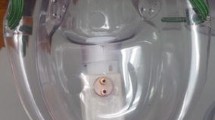Abstract
Objective. The aims of this study were to assess aspects of the response of a small thermocouple to temperature change, and to evaluate whether such a thermocouple could be used intermittently to measure respiratory rate and timing by detecting the changes in nasal temperature occurring with breathing.Methods. The study had three parts. First, three similar, fast-responding thermocouples were immersed repeatedly in warm water. Second, the influence of atmospheric temperature on the signal of a thermocouple placed at different sites within the nasal orifice was studied. The signals produced were continuously displayed and analyzed using a laptop computer to allow evaluation of the thermocouples' response characteristics. Third, simultaneous respiratory recordings were acquired using a nasal thermocouple and a nasal pneumotachograph in 12 teenaged subjects. The respiratory rate and the periods of time taken for inspiration (Ti) and expiration (Te) were calculated and compared.Results. The thermocouples' responses to the temperature changes associated with breathing and immersion into water were rapid and consistent. The rate of the signals' decay, following the peak signal marking expiration, was influenced by the atmospheric temperature. The time constants of the thermocouples were similar (mean time constant=0.41 sec, standard deviation (SD)=0.07). Optimal respiratory recordings were obtained, with least discomfort, when the thermocouple was positioned at 0 to 4 mm within the nasal orifice. In comparing the respiratory recordings acquired simultaneously with a thermocouple and pneumotachograph, the respiratory rates were identical, and the Ti and Te values were similar (mean difference 0.04 sec (95% CI: -0.11 to 0.21 sec) and -0.04 sec (95% CI: -0.20 to 0.12 sec), respectively).Conclusions. Intermittent measurements of respiratory rate and timing using a nasal thermocouple accurately reflected measurements obtained from nasal airflow using a pneumotachograph.
Similar content being viewed by others
References
Szidon JP, Fishman AP. Approach to the pulmonary patient with respiratory symptoms and signs. In: Jeffers JD, Navrozova M, eds. Pulmonary diseases and disorders. New York: McGraw-Hill, 1988:313–366
Bosisio E, Panzuti F, Sergi M. Ventilatory pattern during handgrip in normal man. Respiration 1981;42(2):84–87
South M, Morley CJ. Respiratory timing in intubated neonates with respiratory distress syndrome. Arch Dis Child 1992;67:446–448
Askanazi J, Silverberg PA, Foster RJ, et al. Effects of respiratory apparatus on breathing pattern. J Appl Physiol 1980;48(4):577–580
Gilbert R, Auchincloss JH Jr, Brodsky J, Boden W. Changes in tidal volume, frequency, and ventilation induced by their measurement. J Appl Physiol 1972;33(2):252–254
Loveridge B, West P, Anthonisen NR, Kryger MH. Breathing patterns in patients with chronic obstructive pulmonary disease. Am Rev Respir Dis 1984;130(5):730–733
Onal E, Lopata M. Respiratory timing during NREM sleep in patients with occlusive sleep apnea. J Appl Physiol 1986;61(4):1444–1448
Brimacombe J, MacFie A, Masters A. The extensometer—use in spontaneously ventilating awake volunteers. Anaesthesia 1992;47(10):872–877
Sackner MA. Monitoring of ventilation without a physical connection to the airway. In: Sackner MA, ed. Diagnostic techniques in pulmonary disease. New York: Decker, 1980;16(part 1):503–537
Diefendererfer AJ. AC circuits. In: Pardue HL, Stanley WD, eds. Principles of electronic instrumentation, ed 2. Tokyo, Japan: WB Saunders, 1979:20–56
Simoes EAF, Roark R, Berman S, et al. Respiratory rate: Measurement of variability over time and accuracy at different counting periods. Arch Dis Child 1991;66:1199–1203
Bland JM, Altman DG. Statistical methods for assessing agreement between two methods of clinical measurement. Lancet 1986:307–310
Hagart-Alexander C. Measurement techniques—thermocouples. In: Noltingk BE, ed. Instrumentation reference book, ed 1. London: Butterworth, 1988:28–43
Brown BH. Some new instruments for the continuous monitoring of body temperature, respiration rate and pulse rate. Phys Med Biol 1966;11(1):135–137
Arnson LA, Rau JL, Dixon RJ. Evaluation of two electronic respiratory rate monitoring systems. Resp Care 1981;26(3):221–227
Krieger B, Feinerman D, Zaron A, Bizousky F. Continuous noninvasive monitoring of respiratory rate in critically ill patients. Chest 1986;90(5):632–634
Xiong C, Sjöberg BJ, Sveider P, et al. Problems in timing of respiration with the nasal thermistor technique. J Am Soc Echo 1993;6(2):210–216
Author information
Authors and Affiliations
Additional information
Michael K. Marks was supported by a National Health and Medical Research Council Scholarship.
Rights and permissions
About this article
Cite this article
Marks, M.K., South, M. & Carter, B.G. Measurement of respiratory rate and timing using a nasal thermocouple. J Clin Monitor Comput 11, 159–164 (1995). https://doi.org/10.1007/BF01617716
Received:
Revised:
Accepted:
Issue Date:
DOI: https://doi.org/10.1007/BF01617716




